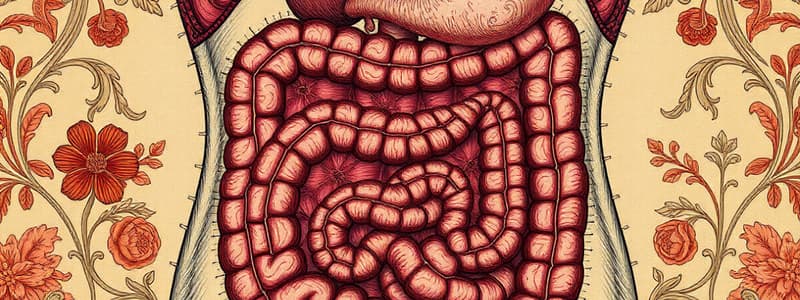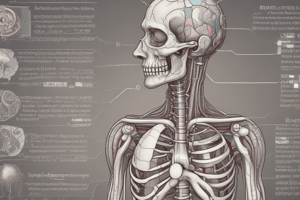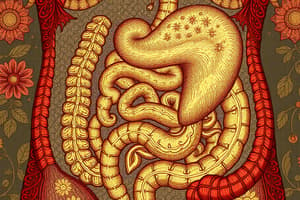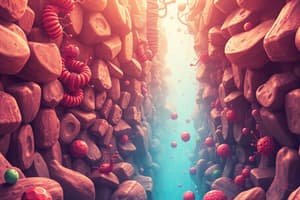Podcast
Questions and Answers
What is the primary function of the lower esophageal sphincter?
What is the primary function of the lower esophageal sphincter?
- To secrete gastric juices into the esophagus.
- To prevent stomach contents from flowing back into the esophagus. (correct)
- To propel the bolus from the pharynx to the stomach.
- To facilitate the breakdown of carbohydrates in the esophagus.
How does the stomach protect itself from the corrosive effects of hydrochloric acid (HCl)?
How does the stomach protect itself from the corrosive effects of hydrochloric acid (HCl)?
- By diluting the acid with water.
- By secreting a layer of mucus. (correct)
- By producing enzymes that break down the acid.
- By neutralizing the acid with bile.
What is the role of the pyloric sphincter in the digestion process?
What is the role of the pyloric sphincter in the digestion process?
- It prevents food from entering the stomach.
- It secretes enzymes that break down proteins in the stomach.
- It produces bile to aid in fat digestion.
- It regulates the release of chyme from the stomach into the small intestine. (correct)
Which component of gastric juice is responsible for breaking down proteins into smaller peptides?
Which component of gastric juice is responsible for breaking down proteins into smaller peptides?
What is the primary function of saliva in the mouth during digestion?
What is the primary function of saliva in the mouth during digestion?
What is the role of peristalsis in the esophagus?
What is the role of peristalsis in the esophagus?
Which of the following occurs primarily in the small intestine?
Which of the following occurs primarily in the small intestine?
Which of the following is NOT considered an accessory organ of the digestive system?
Which of the following is NOT considered an accessory organ of the digestive system?
Which of the following best describes the role of bicarbonate ions in pancreatic juice?
Which of the following best describes the role of bicarbonate ions in pancreatic juice?
What is the primary function of bile in the digestive process?
What is the primary function of bile in the digestive process?
In which sections of the small intestine does the majority of nutrient absorption occur?
In which sections of the small intestine does the majority of nutrient absorption occur?
How do villi and microvilli enhance nutrient absorption in the small intestine?
How do villi and microvilli enhance nutrient absorption in the small intestine?
What is the main function of the large intestine?
What is the main function of the large intestine?
Which of the following describes the correct order of the segments of the colon through which undigested material passes?
Which of the following describes the correct order of the segments of the colon through which undigested material passes?
Aside from bile production, what is another significant metabolic function of the liver?
Aside from bile production, what is another significant metabolic function of the liver?
How does the gallbladder contribute to the digestion process?
How does the gallbladder contribute to the digestion process?
What is the role of insulin and glucagon, produced by the pancreas, in the digestive system?
What is the role of insulin and glucagon, produced by the pancreas, in the digestive system?
How are fat-soluble nutrients absorbed differently compared to water-soluble nutrients?
How are fat-soluble nutrients absorbed differently compared to water-soluble nutrients?
What factors primarily control the process of defecation?
What factors primarily control the process of defecation?
Which enzyme is responsible for breaking down starch into maltose in the mouth?
Which enzyme is responsible for breaking down starch into maltose in the mouth?
Which hormone stimulates the release of enzyme-rich pancreatic juice and bile from the gallbladder?
Which hormone stimulates the release of enzyme-rich pancreatic juice and bile from the gallbladder?
What is the underlying cause of lactose intolerance?
What is the underlying cause of lactose intolerance?
Which digestive disorder is characterized by chronic inflammation of the digestive tract, including conditions like Crohn's disease and ulcerative colitis?
Which digestive disorder is characterized by chronic inflammation of the digestive tract, including conditions like Crohn's disease and ulcerative colitis?
Flashcards
Digestion
Digestion
The breakdown of large, insoluble food molecules into small, water-soluble molecules for absorption into the bloodstream.
Human Digestive System
Human Digestive System
Organ system for ingestion, digestion, absorption, and egestion of food. Includes the alimentary canal and accessory organs.
Alimentary Canal
Alimentary Canal
A continuous tube from mouth to anus, including the mouth, pharynx, esophagus, stomach, small intestine, and large intestine.
Accessory Digestive Organs
Accessory Digestive Organs
Signup and view all the flashcards
Mastication
Mastication
Signup and view all the flashcards
Salivary Amylase
Salivary Amylase
Signup and view all the flashcards
Peristalsis
Peristalsis
Signup and view all the flashcards
Pepsin
Pepsin
Signup and view all the flashcards
Pancreatic Amylase
Pancreatic Amylase
Signup and view all the flashcards
Trypsinogen
Trypsinogen
Signup and view all the flashcards
Lipase
Lipase
Signup and view all the flashcards
Bicarbonate Ions
Bicarbonate Ions
Signup and view all the flashcards
Bile
Bile
Signup and view all the flashcards
Jejunum and Ileum
Jejunum and Ileum
Signup and view all the flashcards
Villi and Microvilli
Villi and Microvilli
Signup and view all the flashcards
Large Intestine
Large Intestine
Signup and view all the flashcards
Liver
Liver
Signup and view all the flashcards
Gallbladder
Gallbladder
Signup and view all the flashcards
Pancreas
Pancreas
Signup and view all the flashcards
Absorption
Absorption
Signup and view all the flashcards
Gastrin
Gastrin
Signup and view all the flashcards
Secretin
Secretin
Signup and view all the flashcards
Celiac Disease
Celiac Disease
Signup and view all the flashcards
Study Notes
- Digestion is the breakdown of large, insoluble food molecules into small, water-soluble molecules so they can be absorbed into the bloodstream.
The Human Digestive System
- Is an organ system responsible for ingestion, digestion, absorption, and egestion of food.
- Consists of the alimentary canal and accessory organs.
- The alimentary canal is a continuous tube that starts at the mouth and ends at the anus, including the mouth, pharynx, esophagus, stomach, small intestine, and large intestine.
- Accessory organs aid digestion by secreting enzymes and other substances into the alimentary canal; these include the salivary glands, liver, gallbladder, and pancreas.
Mouth
- Mechanical digestion begins in the mouth with mastication (chewing), which increases the surface area of food particles.
- Saliva, secreted by the salivary glands, contains salivary amylase (ptyalin), which starts the chemical digestion of starch into maltose.
- Saliva also lubricates the food, making it easier to swallow.
- The tongue helps in mixing food with saliva and forming a bolus, which is then swallowed.
Esophagus
- The bolus passes from the mouth into the pharynx and then into the esophagus.
- The esophagus is a muscular tube that connects the pharynx to the stomach.
- Peristalsis, rhythmic contractions of the esophageal muscles, propels the bolus down to the stomach.
- A sphincter at the end of the esophagus, the lower esophageal sphincter, prevents stomach contents from refluxing back into the esophagus.
Stomach
- The stomach is a J-shaped organ that stores and mixes food.
- Gastric glands in the stomach lining secrete gastric juice, which contains hydrochloric acid (HCl), pepsinogen, and mucus.
- HCl activates pepsinogen into pepsin, a protease that breaks down proteins into smaller peptides.
- HCl also kills bacteria in the ingested food.
- Mucus protects the stomach lining from the corrosive effects of HCl.
- The stomach churns the food, mixing it with gastric juice to form chyme.
- Chyme is gradually released into the small intestine through the pyloric sphincter.
Small Intestine
- The small intestine is the primary site of nutrient digestion and absorption.
- It is a long, coiled tube divided into three sections: the duodenum, jejunum, and ileum.
- The duodenum receives chyme from the stomach, as well as secretions from the pancreas and gallbladder.
- Pancreatic juice contains enzymes such as pancreatic amylase (digests starch into maltose), trypsinogen (activated into trypsin, digests proteins into peptides), lipase (digests fats into fatty acids and glycerol), and bicarbonate ions (neutralize acidic chyme).
- Bile, produced by the liver and stored in the gallbladder, emulsifies fats, increasing their surface area for digestion by lipase.
- The jejunum and ileum are responsible for the absorption of nutrients into the bloodstream.
- The lining of the small intestine is highly folded and covered with villi and microvilli, which increase the surface area for absorption.
- Nutrients are absorbed into the blood capillaries and lacteals (lymphatic vessels) in the villi.
Large Intestine
- The large intestine absorbs water and electrolytes from the remaining undigested material.
- It consists of the cecum, colon (ascending, transverse, descending, and sigmoid), rectum, and anus.
- The cecum is a pouch-like structure that receives undigested material from the small intestine.
- The colon absorbs water and electrolytes, converting the remaining material into feces.
- The rectum stores feces until defecation.
- The anus is the opening through which feces are eliminated from the body.
- The large intestine also contains a diverse community of gut bacteria that ferment undigested carbohydrates, producing gases and short-chain fatty acids.
Liver
- Produces bile, which is stored in the gallbladder and released into the duodenum to emulsify fats.
- Plays a role in carbohydrate, protein, and fat metabolism.
- Detoxifies harmful substances, such as alcohol and drugs.
- Stores glycogen, vitamins, and minerals.
- Synthesizes plasma proteins, such as albumin and clotting factors.
Gallbladder
- Stores and concentrates bile produced by the liver.
- Releases bile into the duodenum to aid in fat digestion.
Pancreas
- Secretes pancreatic juice into the duodenum, which contains enzymes for digesting carbohydrates, proteins, and fats
- Produces hormones, such as insulin and glucagon, which regulate blood sugar levels.
Absorption
- The process by which digested nutrients move from the small intestine into the bloodstream or lymphatic system
- Most nutrients are absorbed in the jejunum and ileum of the small intestine
- Villi and microvilli increase the surface area for absorption
- Nutrients are transported across the epithelial cells of the villi into blood capillaries and lacteals
- Water-soluble nutrients (e.g., glucose, amino acids, vitamins) are absorbed directly into the bloodstream
- Fat-soluble nutrients (e.g., fatty acids, glycerol, fat-soluble vitamins) are absorbed into lacteals and then transported to the bloodstream
Defecation
- The process of eliminating feces from the body through the anus.
- Feces consist of undigested food material, bacteria, and waste products.
- Defecation is controlled by the anal sphincters, which are both internal (involuntary) and external (voluntary).
Enzymes Involved in Digestion
- Salivary Amylase: Produced in the salivary glands, breaks down starch into maltose.
- Pepsin: Produced in the stomach (as pepsinogen), breaks down proteins into peptides.
- Pancreatic Amylase: Produced in the pancreas, continues the breakdown of starch to maltose.
- Trypsin: Produced in the pancreas (as trypsinogen), breaks down proteins into peptides.
- Lipase: Produced in the pancreas, breaks down fats into fatty acids and glycerol.
- Maltase: Produced in the small intestine, breaks down maltose into glucose.
- Sucrase: Produced in the small intestine, breaks down sucrose into glucose and fructose.
- Lactase: Produced in the small intestine, breaks down lactose into glucose and galactose.
- Peptidases: Produced in the small intestine, break down peptides into amino acids.
Hormonal Control of Digestion
- Gastrin: Stimulates the secretion of gastric juice in the stomach.
- Secretin: Stimulates the secretion of bicarbonate-rich pancreatic juice.
- Cholecystokinin (CCK): Stimulates the release of bile from the gallbladder and enzyme-rich pancreatic juice.
- Gastric Inhibitory Peptide (GIP): Inhibits gastric secretion and motility, stimulates insulin release.
Common Digestive Disorders
- Heartburn and Gastroesophageal Reflux Disease (GERD): Occur when stomach acid flows back into the esophagus, causing a burning sensation.
- Peptic Ulcers: Sores in the lining of the stomach or duodenum, often caused by Helicobacter pylori infection or NSAID use.
- Gallstones: Hard deposits that form in the gallbladder, causing pain and indigestion.
- Lactose Intolerance: Inability to digest lactose due to a deficiency of lactase, leading to bloating, gas, and diarrhea.
- Celiac Disease: An autoimmune disorder triggered by gluten, damaging the lining of the small intestine and impairing nutrient absorption.
- Irritable Bowel Syndrome (IBS): A common disorder that affects the large intestine, causing abdominal pain, bloating, gas, diarrhea, and constipation.
- Inflammatory Bowel Disease (IBD): Includes Crohn's disease and ulcerative colitis, chronic inflammatory conditions of the digestive tract.
Studying That Suits You
Use AI to generate personalized quizzes and flashcards to suit your learning preferences.




